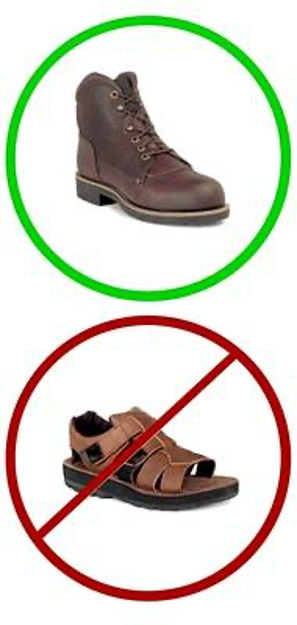
Photo by: Kit Galvin
 Idea...
Idea...
Research has shown that pesticide levels in farmworker’s homes and vehicles were higher than non-farmworkers. Most of them did not have a place at work to change or store their work clothes and boots. We tested the boot bin with farmworkers to see if they liked it. They did!
 Alert
Alert
Remember, to not wear work boots in your commute vehicle or home. Store your boots outside the house and away from children and pets.
 Supplies
Supplies
- Plastic container with a secure lid.
- Blank labels for printing warning signs.
- Downloadable warning signs PDF from the Boot Bin website.
- No street shoes
- Work boots only
 Setup & use
Setup & use
- Print and attach warning symbols on the top of the boot bin.
- Change into work boots at work.
- Store street shoes in a clean separate plastic bag or bin.
- Place bag in the vehicle and not in the boot bin.
- Change out of work boots and into street shoes just before going home.
- Put boots in the boot bin and place it in a non-passenger area of your vehicle.


 Tips
Tips
- Prop the lid open to dry out work boots.
- Clean the inside and outside of the boot bin regularly with soap and water. Remember to wear chemical protectives gloves when cleaning.
Resources
National Pesticide Information Center: Common Pesticides Questions
National Ag Safety Database: Practical Solutions for Pesticide Safety
- Reducing Family Exposure (English)
- Protegiendo a los Manipuladores de Pesticidas Agrícolas (Spanish)
We hope that you will be inspired you to incorporate solutions into your own training style, develop your own hands-on teaching tools, or discover new practical solutions. We hope that you are inspired to use these solutions in your workplace. Did you try one of the practical solutions or develop a new one? We would appreciate hearing about your ideas and experiences.
Thank you and safe pesticide handling,
PNASH
Contact your state agency for more information on WPS regulations. The content of this website is for informational purposes only. It may need modification to fit your needs or it may not be appropriate for your workplace. Safe use of these solutions is your responsibility. The University of Washington and the Pacific Northwest Agricultural Safety & Health Center is not responsible for any loss or damage resulting from the use of the information provided on this website.
PNASH Project 2016-2021 (CDC/NIOSH Cooperative Agreement # U54 OH007544)
Contact us
Project Email:
PractSol@uw.edu
Project staff:
Maria Tchong-French (habla español)
206 685-6728
